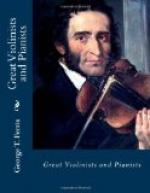leader at the Genoese theatre, that he undertook to
instruct the gifted child. Two years later the
young Paganini was transferred to the charge of Signor
Giacomo Costa, an excellent violinist, and director
of church music at one of the cathedrals, under whom
he made rapid progress in executive skill, while he
studied harmony and counterpoint under the composer
Gnecco. It was at this time, Paganini not yet
being nine years of age, that he composed his first
piece, a sonata now lost. In 1793 he made his
first appearance in public at Genoa, and played variations
on the air “La Carmagnole,” then so popular,
with immense effect. This
debut was followed
by several subsequent appearances, in which he created
much enthusiasm. He also played a violin concerto
every Sunday in church, an attraction which drew great
throngs. This practice was of great use to Paganini,
as it forced him continually to study fresh music.
About the year 1795 it was deemed best to place the
boy under the charge of an eminent professor, and
Alessandro Rolla, of Parma, was pitched on. When
the Paganinis arrived, they found the learned professor
ill, and rather surly at the disturbance. Young
Paganini, however, speedily silenced the complaints
of the querulous invalid. The great player himself
relates the anecdote: “His wife showed us
into a room adjoining the bedroom, till she had spoken
to the sick man. Finding on the table a violin
and the music of Rolla’s latest concerto, I took
up the instrument and played the piece at sight.
Astonished at what he heard, the composer asked for
the name of the player, and could not believe it was
only a young boy till he had seen for himself.
He then told me that he had nothing to teach me, and
advised me to go to Paer for study in composition.”
But, as Paer was at this time in Germany, Paganini
studied under Ghiretti and Rolla himself while he remained
in Parma, according to the monograph of Fetis.
The youthful player had already begun to search out
new effects on the violin, and to create for himself
characteristics of tone and treatment hitherto unknown
to players. After his return to Genoa he composed
his first “Etudes,” which were of such
unheard-of difficulty that he was sometimes obliged
to practice a single passage ten hours running.
His intense study resulted not only in his acquirement
of an unlimited execution, but in breaking down his
health. His father was a harsh and inexorable
taskmaster, and up to this time Paganini (now being
fourteen) had remained quiescent under this tyrant’s
control. But the desire of liberty was breeding
projects in his breast, which opportunity soon favored.
He managed to get permission to travel alone for the
first time to Lucca, where he had engaged to play
at the musical festival in November, 1798. He
was received with so much enthusiasm that he determined
not to return to the paternal roof, and at once set
off to fulfill engagements at Pisa and other towns.
In vain the angry and mortified father sought to reclaim
the young rebel who had slipped through his fingers.
Nicolo found the sweets of freedom too precious to
go back again to bondage, though he continued to send
his father a portion of the proceeds of his playing.




